Palaeoenvironmental Synthesis of the Eastern Ebro Basin Loess–Palaeosol Sequences (LPSs)
Abstract
1. Introduction
2. Methodology
2.1. Profile Description and Sampling
2.2. Physical and Chemical Analyses
2.3. Preparation of Thin Sections and Micromorphological Analysis
2.4. Luminescence Dating
2.5. Specific Research
2.5.1. Identification of Source Areas
2.5.2. Structural and Textural Porosity
2.5.3. Study of Secondary Carbonate Accumulations
2.5.4. Study of a Type of Biocalcification, “Queras”
Morphological and Micromorphological Analysis of Queras
Radiocarbon Dating and Isotopic Composition of Queras
2.5.5. Pedogenic Gypsum Accumulations
Isotope Analysis of Sulphate (δ34S and δ18O) and of Hydration Water of Gypsum (δ2H and δ18O)
Minor and Trace Elements of Pedogenic Gypsum
3. Results
3.1. General Characterisation
3.1.1. Morphological Descriptions
3.1.2. Physical and Chemical Analyses
3.1.3. Micromorphological Characterisation
3.1.4. Dating of the Loess–Palaeosol Sequences
3.2. Study of Porosity
3.2.1. Structural Porosity: Scanned Images and High-Resolution Mosaics
3.2.2. Textural Porosity
3.3. Secondary Carbonate Accumulations
3.3.1. Study of a Type of Biocalcifications, Called “Queras”
Morphological Analysis and Micromorphology Descriptions of Queras
Radiocarbon Dating and Isotopic Composition
3.4. Study of Pedogenic Gypsum with Different Techniques
3.4.1. Morphological and Micromorphological Description of Pedogenic Gypsum Accumulations
3.4.2. Sulphate Isotopic Analysis of Gypsum (δ34S and δ18O)
3.4.3. Isotopic Analysis of Gypsum Hydration Water (δ18O and δ2H)
3.4.4. Analysis of Trace Elements
4. Discussion
4.1. Common Features of the Loess–Palaeosol Sequences
4.2. Distinct Pedofeatures: Rubefaction, Secondary Carbonate Accumulations, and Pedogenic Gypsum
4.3. Regional Variability of Soil-Forming Factors
- Relief:
- Parent Material
- Biological Activity
- Climate
- Time
- Sedimentation Rate
4.4. Limitations of the Methodology and Future Proposals
5. Conclusions
- (a)
- Main characterisation of the LPS of the NE Iberian Peninsula
- (b)
- Specific research and its relation to soil-forming processes
- (c)
- Soil-forming factors
- (d)
- Methodological limitations
Author Contributions
Funding
Data Availability Statement
Conflicts of Interest
References
- Smalley, I.J.; Marković, S.B. Loessification and hydroconsolidation: There is a connection. Catena 2014, 117, 94–99. [Google Scholar] [CrossRef]
- Luo, H.; Wu, F.; Chang, J.; Xu, J. Microstructural constraints on geotechnical properties of Malan Loess: A case study from Zhaojiaan landslide in Shaanxi province, China. Eng. Geol. 2018, 236, 60–69. [Google Scholar] [CrossRef]
- Yaalon, D.H. Saharan dust and desert loess: Effect on surrounding soils. J. Afr. Earth Sci. 1987, 6, 569–571. [Google Scholar] [CrossRef]
- Smalley, I.J.; Krinsley, D.H. Loess deposits associated with deserts. Catena 1978, 5, 53–66. [Google Scholar] [CrossRef]
- Obruchev, V.A. Loess types and their origin. Am. J. Sci. 1945, 243, 256–262. [Google Scholar] [CrossRef]
- Smalley, I. The Formation of Loess Materials and Loess Deposits: Some Observations on the Tashkent Loess. In Loess Letter; Olszak, G., Ed.; De Gruyter: Berlin, Germany; Boston, MA, USA, 1980; Volume 2, Issue 2, pp. 247–258. [Google Scholar] [CrossRef]
- Iriondo, M.H.; Kröhling, D.M. Non-classical types of loess. Sediment. Geol. 2007, 202, 352–368. [Google Scholar] [CrossRef]
- Wright, J.S. “Desert” loess versus “glacial” loess: Quartz silt formation, source areas and sediment pathways in the formation of loess deposits. Geomorphology 2001, 36, 231–256. [Google Scholar] [CrossRef]
- Pye, K.; Sherwin, D. Loess. In Aeolian Environments, Sediments and Landforms; Goudie, A.S., Livingstone, I., Stokes, S., Eds.; Wiley: Chichester, UK, 1999; pp. 213–238. [Google Scholar]
- Vandenberghe, J. Multi-proxy analysis: A reflection on essence and potential pitfalls. Neth. J. Geosci. 2012, 91, 263–269. [Google Scholar] [CrossRef]
- Morrison, R.B. Quaternary soil stratigraphy—Concepts, methods and problems. In Quaternary Soils; Geo Abstracts Ltd.: Norwich, UK, 1978; pp. 77–108. [Google Scholar]
- Pécsi, M. Loess is not just the accumulation of dust. Quat. Int. 1990, 7–8, 1–21. [Google Scholar] [CrossRef]
- Pécsi, M. The role of principles and methods in loess-paleosol investigations. GeoJournal 1995, 36, 117–131. [Google Scholar] [CrossRef]
- Pye, K. The nature, origin and accumulation of loess. Quat. Sci. Rev. 1995, 14, 653–667. [Google Scholar] [CrossRef]
- Rousseau, D.-D.; Antoine, P.; Gerasimenko, N.; Sima, A.; Fuchs, M.; Hatté, C.; Moine, O.; Zoeller, L. North Atlantic abrupt climatic events of the last glacial period recorded in Ukrainian loess deposits. Clim. Past 2011, 7, 221–234. [Google Scholar] [CrossRef]
- Antoine, P.; Rousseau, D.D.; Fuchs, M.; Hatté, C.; Gauthier, C.; Marković, S.B.; Jovanović, M.; Gaudenyi, T.; Moine, O.; Rossignol, J. High-resolution record of the last climatic cycle in the southern Carpathian Basin (Surduk, Vojvodina, Serbia). Quat. Int. 2009, 198, 19–36. [Google Scholar] [CrossRef]
- Antoine, P.; Rousseau, D.D.; Moine, O.; Kunesch, S.; Hatté, C.; Lang, A.; Tissoux, H.; Zöller, L. Rapid and cyclic aeolian deposition during the Last Glacial in European loess: A high-resolution record from Nussloch, Germany. Quat. Sci. Rev. 2009, 28, 2955–2973. [Google Scholar] [CrossRef]
- Frechen, M.; Oches, E.A.; Kohfeld, K.E. Loess in Europe—Mass accumulation rates during the Last Glacial Period. Quat. Sci. Rev. 2003, 22, 1835–1857. [Google Scholar] [CrossRef]
- Coudé-Gaussen, G. The loess and loess-like deposits along the sides of the western Mediterranean Sea: Genetic and palaeoclimatic significance. Quat. Int. 1990, 5, 1–8. [Google Scholar] [CrossRef]
- Crouvi, O.; Amit, R.; Ben Israel, M.; Enzel, Y. Loess in the Negev desert: Sources, loessial soils, palaeosols, and palaeoclimatic implications. In Quaternary of the Levant: Environments, Climate Change, and Humans; Bar-Yosef, O., Enzel, Y., Eds.; Cambridge University Press: Cambridge, UK, 2017; pp. 471–482. [Google Scholar]
- Lehmkuhl, F.; Nett, J.J.; Pötter, S.; Schulte, P.; Sprafke, T.; Jary, Z.; Antoine, P.; Wacha, L.; Wolf, D.; Zerboni, A.; et al. Loess landscapes of Europe—Mapping, geomorphology, and zonal differentiation. Earth-Sci. Rev. 2021, 215, 103496. [Google Scholar] [CrossRef]
- González-Martín, J.A.; Asensio, I.; Fernández, A.; García-Giménez, R.; González, M.J.; Guerrero, L.; Rubio, V. Acumulaciones de origen frío en el modelado de los paisajes de la Rama castellana del Sistema Ibérico y de la Submeseta Sur. In Procesos y Formas Periglaciares en la Montaña Mediterránea; Lozano-Tena, M.V.J., Peña-Monné, J.L., Sánchez-Fabre, M., Eds.; Instituto de Estudios Turolenses: Teruel, Spain, 2000; pp. 149–160. [Google Scholar]
- Günster, N.; Eck, P.; Skowronek, A.; Zöller, L. Late Pleistocene loess and their paleosols in the Granada Basin, Southern Spain. Quat. Int. 2001, 76–77, 241–245. [Google Scholar] [CrossRef]
- García Giménez, R.; Vigil de la Villa, R.; González Martín, J.A. Characterization of loess in central Spain: A microstructural study. Environ. Earth Sci. 2012, 65, 2125–2137. [Google Scholar] [CrossRef]
- Torras, A.; Riba, O. Contribución al estudio de los limos yesíferos del centro de la depresión del Ebro. Bol. Inst. Estud. Astur. Supl. Cienc. 1968, 14, 125–137. [Google Scholar]
- Mücher, H.; Sevink, J.; Bergkamp, G.; Jongejans, J. A pedological and micromorphological study on Mediterranean loessial deposits near Gerona, NE Spain. Quat. Int. 1990, 5, 9–22. [Google Scholar] [CrossRef]
- Gutiérrez-Elorza, M.; Desir, G.; Gutiérrez-Santolalla, F. Yardangs in the semiarid central sector of the Ebro Depression (NE Spain). Geomorphology 2002, 44, 155–170. [Google Scholar] [CrossRef]
- Iriondo, M.; Kröhling, D. Loess yesíferos en el Cuaternario Superior de la Cuenca del Ebro (España): Características generales. In Miscelánea en Homenaje a Emiliano Aguirre; Rubió, S., Ed.; Museo Arqueológico Regional: Madrid, Spain, 2004; pp. 45–50. [Google Scholar]
- Josa, R. Estudi Cronoseqüencial de Sols Sobre Les Terrasses de L’anoia: Entre El Bedorc I Gelida. Ph.D. Thesis, Universitat de Barcelona, Facultat de Geologia, Barcelona, Spain, 1985. [Google Scholar]
- Lewis, C.J.; McDonald, E.V.; Sancho, C.; Peña, J.L.; Rhodes, E.J. Climatic implications of correlated Upper Pleistocene glacial and fluvial deposits on the Cinca and Gállego Rivers (NE Spain) based on OSL dating and soil stratigraphy. Glob. Planet. Change 2009, 67, 141–152. [Google Scholar] [CrossRef]
- Boixadera, J.; Poch, R.M.; Lowick, S.E.; Balasch, J.C. Loess and soils in the eastern Ebro Basin. Quat. Int. 2015, 376, 114–133. [Google Scholar] [CrossRef]
- Plata Moreno, J.M. Loess in the Eastern Ebro Valley: Source Areas and Red Soil Genesis. Ph.D. Thesis, Universitat de Lleida, Programa de Doctorat en Ciència i Tecnologia Agrària i Alimentària, Lleida, Spain, 2023. [Google Scholar]
- Plata, J.M.; Balasch, J.C.; Rodríguez, R.; Boixadera, J.; Castelltort, X.; Olarieta, J.R.; Antúnez, M.; Poch, R.M. Source areas of the Eastern Ebro Valley loess (NE Iberian Peninsula): Heavy mineral composition as a provenance indicator. Earth Surf. Process. Landf. 2022, 47, 3611–3628. [Google Scholar] [CrossRef]
- Plata, J.M.; Balasch, J.C.; Boixadera, J.; Baltiérrez, A.; Preusser, F.; Poch, R.M. Source areas and paleoenvironmental reconstruction of the Serra d’Almenara loess (NE Ebro Valley, Iberian Peninsula) from grain-size and heavy mineral signatures. Geomorphology 2024, 451, 109085. [Google Scholar] [CrossRef]
- Plata, J.M.; Rodríguez, R.; Preusser, F.; Boixadera, J.; Balasch, J.C.; Antúnez, M.; Poch, R.M. Red soils in loess deposits of the Western Ebro Valley. Catena 2021, 204, 105430. [Google Scholar] [CrossRef]
- Torres-Guerrero, C.A.; Álvarez, D.; Preusser, F.; Olarieta, J.R.; Poch, R.M. Corrigendum to “Evolution of soil porosity in loess-palaeosol sequences of the Ebro Valley, NE Iberia” [Catena 230 (2023) 107244]. Catena 2023, 236, 2023–2025. [Google Scholar] [CrossRef]
- Álvarez, D.; Torres-Guerrero, C.A.; Travé, A.; Preusser, F.; Plata, J.M.; Poch, R.M. Biogenic carbonates (queras) in loess-palaeosol sequences of the Ebro Basin and their potential use as a palaeoenvironmental proxy. Catena 2024, 240, 107969. [Google Scholar] [CrossRef]
- Álvarez, D.; Torres-Guerrero, C.; Boixadera, J.; Balasch, C.; Plata, J.M.; Rodríguez-Ochoa, R.; Olarieta, J.R.; Poch, R.M. Isotopy, Micromorphology and Composition of Pedogenic Gypsum in Loess-Palaeosol Sequences in the Ebro Valley as a Combined Paleoenvironmental Proxy. Geoderma 2024, in print. [Google Scholar]
- Zoeller, L. New approaches to European loess: A stratigraphic and methodical review of the past decade. Cent. Eur. J. Geosci. 2010, 2, 19–31. [Google Scholar] [CrossRef]
- Comisión del Banco de Datos de Suelos y Aguas. SINEDARES. Sistema de Información Edafológica y Agronómica de España, Manual Para la Descripción Codificada de Suelos en el Campo; Ministerio de Agricultura, Pesca y Alimentación: Madrid, Spain, 1983. [Google Scholar]
- Porta, J.; Lopez-Acevedo Reguerin, M.; Rodriguez-Ochoa, R. Técnicas y Experimentos en Edafología; Col·legi Oficial d’Enginyers Agrònoms de Catalunya: Catalunya, Spain, 1986. [Google Scholar]
- Artieda, O.; Herrero, J.; Drohan, P.J. Developing an arid soil-specific hypersaline solution for soil electrical conductivity analysis. Commun. Soil Sci. Plant Anal. 2006, 37, 2431–2441. [Google Scholar]
- Benyarku, C.A.; Stoops, G. Guidelines for Preparation of Rock and Soil Thin Sections and Polished Sections; Universitat de Lleida, Departament de Medi Ambient i Ciències del Sòl: Lleida, Spain, 2005. [Google Scholar]
- Stoops, G. Guidelines for Analysis and Description of Soil and Regolith Thin Sections; Soil Science Society of America: Madison, WI, USA, 2021. [Google Scholar] [CrossRef]
- Galbraith, R.F.; Roberts, R.G. Statistical aspects of equivalent dose and error calculation and display in OSL dating: An overview and some recommendations. Quat. Geochronol. 2012, 11, 1–27. [Google Scholar] [CrossRef]
- Kreutzer, S.; Burow, C.; Dietze, M.; Fuchs, M.C.; Schmidt, C.; Fischer, M.; Friedrich, J.; Riedesel, S.; Autzen, M.; Mittelstrass, D. Luminescence: Comprehensive Luminescence Dating Data Analysis, R Package Version 0.9.10. Available online: https://CRAN.R-project.org/package=Luminescence (accessed on 17 April 2025).
- Li, B.; Li, S.H. Luminescence dating of K-feldspar from sediments: A protocol without anomalous fading correction. Quat. Geochronol. 2011, 6, 468–479. [Google Scholar] [CrossRef]
- Preusser, F.; Kasper, H. The Last Glacial Maximum in Central Europe: Evidence from loess-paleosol sequences in northern Germany. Quat. Sci. Rev. 2001, 20, 1757–1774. [Google Scholar]
- Preusser, F.; Degering, D.; Fülling, A.; Miocic, J. Complex dose rate calculations in luminescence dating of lacustrine and palustrine sediments from Niederweningen, northern Switzerland. Geochronometria 2023, 50, 28–49. [Google Scholar] [CrossRef]
- Nathan, R.P.; Mauz, B. On the dose-rate estimate of carbonate-rich sediments for trapped charge dating. Radiat. Meas. 2008, 43, 14–25. [Google Scholar] [CrossRef]
- Degering, D.; Degering, A. Change is the only constant—Time-dependent dose rates in luminescence dating. Quat. Geochronol. 2020, 58, 101074. [Google Scholar] [CrossRef]
- Crouvi, O.; Amit, R.; Enzel, Y.; Porat, N.; Sandler, A. Sand dunes as a major proximal dust source for late Pleistocene loess in the Negev Desert, Israel. Quat. Res. 2008, 70, 275–282. [Google Scholar] [CrossRef]
- Bertran, P.; Bosq, M.; Borderie, Q.; Coussot, C.; Coutard, S.; Deschodt, L.; Franc, O.; Gardère, P.; Liard, M.; Wuscher, P. Revised map of European aeolian deposits derived from soil texture data. Quat. Sci. Rev. 2021, 266, 107085. [Google Scholar] [CrossRef]
- Mange, A.; Mauer, H. Heavy Minerals in Colour; Springer: Dordrecht, The Netherlands, 1992. [Google Scholar] [CrossRef]
- Andò, S.; Garzanti, E.; Padoan, M.; Limonta, M. Corrosion of heavy minerals during weathering and diagenesis: A catalog for optical analysis. Sediment. Geol. 2012, 280, 165–178. [Google Scholar] [CrossRef]
- Fernández, J.E. Los Minerales Pesados Del Mioceno de la Fosa Neógena Del Vallès-Penedès. Caracterización, Evaluación E Hipótesis de Procedencia. Ph.D. Thesis, Universitat de Barcelona, Departament de Mineralogia, Petrologia i Geologia Aplicada, Barcelona, Spain, 2016. Available online: http://hdl.handle.net/10803/400615 (accessed on 28 September 2016).
- Sandatlas. Informational Website Focused on Sand, Rocks, Minerals, etc. Available online: https://www.sandatlas.org/ (accessed on 28 February 2021).
- Hammer, Ø.; Harper, D.A.T.; Ryan, P.D. PAST—Palaeontological statistics, ver. 1.89. Palaeontol. Electron. 2001, 4, 1–9. [Google Scholar]
- Gutiérrez-Castorena, E.V.; Gutiérrez-Castorena, M.C.; Vargas, T.G.; Bontemps, L.C.; Martínez, J.D.; Méndez, E.S.; Solorio-Ortíz, C.A. Micromapping of microbial hotspots and biofilms from different crops using digital image mosaics of soil thin sections. Geoderma 2016, 279, 11–21. [Google Scholar] [CrossRef]
- Schindelin, J.; Arganda-Carreras, I.; Frise, E.; Kaynig, V.; Longair, M.; Pietzsch, T.; Preibisch, S.; Rueden, C.; Saalfeld, S.; Schmid, B.; et al. Fiji: An open-source platform for biological image analysis. Nat. Methods 2012, 9, 676–682. [Google Scholar] [CrossRef]
- Vogel, H.J. Quantim4 C/C++ Library for Scientific Image Processing; UFZ—Helmholtz Center for Environmental Research, Helmholtz: Leipzig, Germany, 2008; Available online: https://www.ufz.de/export/data/2/94413_quantim4_ref_manual.pdf (accessed on 20 October 2008).
- Ma, F.L.; Bai, X.H.; Wang, M. Quantitative analysis of loess microstructure and collapsibility. In Proceedings of the 1st Annual Conference of Civil Engineering in Central and Western China, Jinan, China, 14 October 2011; pp. 417–424. [Google Scholar]
- Sauzet, O.; Cammas, C.; Gilliot, J.M.; Bajard, M.; Montagne, D. Development of a novel image analysis procedure to quantify biological porosity and illuvial clay in large soil thin sections. Geoderma 2017, 292, 135–148. [Google Scholar] [CrossRef]
- Comber, A.; Fisher, P.F.; Brunsdon, C.; Khmag, A. Spatial analysis of remote sensing image classification accuracy. Remote Sens. Environ. 2012, 127, 237–246. [Google Scholar] [CrossRef]
- Jiao, L.; Liu, Y. Analyzing the shape characteristics of land use classes in remote sensing imagery. ISPRS Ann. Photogramm. Remote Sens. Spat. Inf. Sci. 2012, I-7, 135–140. [Google Scholar] [CrossRef]
- Bonnie, J.H.M.; Fens, T.W. Porosity and permeability from SEM based image analysis of core material. In Proceedings of the SPE Latin America Petroleum Engineering Conference, Caracas, Venezuela, 8–11 March 1992. [Google Scholar] [CrossRef]
- Reed, S.J.B. Scanning electron microscopy. In Electron Microscopy and Analysis; Reed, S.J.B., Ed.; CRC Press: Boca Raton, FL, USA, 2005. [Google Scholar]
- Barta, G. Secondary carbonates in loess-paleosol sequences: A general review. Open Geosci. 2011, 3, 129–146. [Google Scholar] [CrossRef]
- Herrero, J.; Porta, J.; Fédoroff, N. Hypergypsic soil micromorphology and landscape relationships in Northeastern Spain. Soil Sci. Soc. Am. J. 1992, 56, 1188–1194. [Google Scholar] [CrossRef]
- Reimer, P.J. Composition and consequences of the IntCal20 radiocarbon calibration curve. Quat. Res. 2020, 96, 22–27. [Google Scholar] [CrossRef]
- Drăzíc, S.; Sladoje, N.; Lindblad, J. Estimation of Feret’s diameter from pixel coverage representation of a shape. Pattern Recognit. Lett. 2016, 80, 37–45. [Google Scholar] [CrossRef]
- Cantarero, I.; Travé, A.; Alías, G.; Baqués, V. Pedogenic products sealing normal faults (Barcelona Plain, NE Spain). J. Geochem. Explor. 2010, 106, 44–52. [Google Scholar] [CrossRef]
- Reimer, P.; Bard, E.; Bayliss, A.; Beck, J.; Blackwell, P.; Ramsey, C.; Van der Plicht, J. IntCal13 and Marine13 Radiocarbon Age Calibration Curves 0–50,000 Years cal BP. Radiocarbon 2013, 55, 1869–1887. [Google Scholar] [CrossRef]
- Cerling, T.E.; Quade, J. Stable carbon and oxygen isotopes in soil carbonates. Geophys. Monogr. Ser. 1993, 78, 217–231. [Google Scholar]
- Dworkin, S.I.; Nordt, L.; Atchley, S. Determining terrestrial paleotemperatures using the oxygen isotopic composition of pedogenic carbonate. Earth Planet. Sci. Lett. 2005, 237, 56–68. [Google Scholar] [CrossRef]
- Buck, B.J.; Van Hoesen, J. Snowball morphology and SEM analysis of pedogenic gypsum, Southern New Mexico, USA. J. Arid. Environ. 2002, 51, 469–487. [Google Scholar] [CrossRef]
- Rohrssen, M.; Brunner, B.; Mielke, R.E.; Coleman, M. Method for simultaneous oxygen and hydrogen isotope analysis of water of crystallization in hydrated minerals. Anal. Chem. 2008, 80, 7084–7089. [Google Scholar] [CrossRef]
- Gázquez, F.; Calaforra, J.M.; Evans, N.P.; Hodell, D.A. Using stable isotopes (δ17O, δ18O and δD) of gypsum hydration water to ascertain the role of water condensation in the formation of subaerial gypsum speleothems. Chem. Geol. 2017, 452, 34–46. [Google Scholar] [CrossRef]
- Craig, H. Isotopic variations in meteoric waters. Science 1961, 133, 1702–1703. [Google Scholar] [CrossRef]
- Poch, R.M.; De Coster, W.; Stoops, G. Pore space characteristics as indicators of soil behaviour in gypsiferous soils. Geoderma 1998, 87, 87–109. [Google Scholar] [CrossRef]
- Machette, M.N. Dating Quaternary faults in the southwestern United States by using buried calcific paleosols. U.S. Geol. Surv. J. Res. 1978, 6, 369. [Google Scholar]
- Schoeneberger, P.J.; Wysocki, D.A.; Benham, E.C.; Soil Survey Staff. Field Book for Describing and Sampling Soils; Version 3.0; Natural Resources Conservation Service, National Soil Survey Center: Lincoln, NE, USA, 2012. [Google Scholar]
- Fedoroff, N.; Courty, M.-A. Revisiting the genesis of red Mediterranean soils. Turk. J. Earth Sci. 2013, 22, 359–375. [Google Scholar] [CrossRef]
- Bryant, R.B. Physical processes of fragipan formation. In Fragipans: Their Occurrence, Classification, and Genesis; Soil Science Society of America Special Publications: Madison, WI, USA, 1989; Volume 24, pp. 141–150. [Google Scholar] [CrossRef]
- Jing, J.; Hou, J.; Sun, W.; Chen, G.; Ma, Y.; Ji, G. Study on influencing factors of unsaturated loess slope stability under dry-wet cycle conditions. J. Hydrol. 2022, 612, 128187. [Google Scholar] [CrossRef]
- Carrión, J.S.; Fernández, S.; González-Sampériz, P.; Gil-Romera, G.; Badal, E.; Carrión-Marco, Y.; López-Merino, L.; López-Sáez, A.; Fierro, E.; Burjachs, F. Expected trends and surprises in the Lateglacial and Holocene vegetation history of the Iberian Peninsula and Balearic Islands. Rev. Palaeobot. Palynol. 2010, 162, 458–475. [Google Scholar] [CrossRef]
- González-Sampériz, P.; Valero-Garcés, B.L.; Carrión, J.S.; Peña-Monné, J.L.; García-Ruiz, J.M.; Martí-Bono, C. Glacial and lateglacial vegetation in northeastern Spain: New data and a review. Quat. Int. 2005, 140–141, 4–20. [Google Scholar] [CrossRef]
- González-Sampériz, P.; Valero-Garcés, B.L.; Moreno, A.; Morellón, M.; Navas, A.; Machín, J.; Delgado-Huertas, A. Vegetation changes and hydrological fluctuations in the Central Ebro Basin (NE Spain) since the Late Glacial period: Saline lake records. Palaeogeogr. Palaeoclimatol. Palaeoecol. 2008, 259, 157–181. [Google Scholar] [CrossRef]
- Schwertmann, U. Relations between iron oxides, soil color, and soil formation. In Soil Color; Soil Science Society of America Special Publications: Madison, WI, USA, 1993; Volume 31, pp. 51–69. [Google Scholar] [CrossRef]
- Herrero, J.; Porta, J. Gypsiferous soils in the North-East of Spain. In Micromorphologie des Sols, Soil Micromorphology; Fedoroff, N., Bresson, L.M., Courty, M.A., Eds.; AFES: Paris, France, 1987; pp. 186–192. [Google Scholar]
- Langford, H.E.; Boreham, S.; Coope, G.R.; Fletcher, W.; Horne, D.J.; Keen, D.H.; Mighall, T.; Penkman, K.E.H.; Schreve, D.C.; Whittaker, J.E. Palaeoecology of a late MIS 7 interglacial deposit from eastern England. Quat. Int. 2014, 341, 27–45. [Google Scholar] [CrossRef]
- Pfaffner, N.; Kadereit, A.; Karius, V.; Kolb, T.; Kreutzer, S.; Sauer, D. Reconstructing the Eemian to Middle Pleniglacial pedosedimentary evolution of the Baix loess-palaeosol sequence (Rhône Rift Valley, southern France)—Basic chronostratigraphic framework and palaeosol characterisation. EG Quat. Sci. J. 2024, 73, 1–22. [Google Scholar] [CrossRef]
- Landi, A.; Mermut, A.R.; Anderson, D.W. Origin and rate of pedogenic carbonate accumulation in Saskatchewan soils, Canada. Geoderma 2003, 117, 143–156. [Google Scholar] [CrossRef]
- Retallack, G.J. Pedogenic carbonate proxies for amount and seasonality of precipitation in paleosols. Geology 2005, 33, 333–336. [Google Scholar] [CrossRef]
- Badía, D.; Martí, C.; Palacio, E.; Sancho, C.; Poch, R.M. Soil evolution over the Quaternary period in a semiarid climate (Segre River terraces, northeast Spain). Catena 2009, 77, 165–174. [Google Scholar] [CrossRef]
- Monger, C.H. Pedogenic carbonate: Links between biotic and abiotic CaCO3. In Proceedings of the 17th World Congress of Soil Science, Bangkok, Thailand, 14–21 August 2002. [Google Scholar]
- Zamanian, K.; Pustovoytov, K.; Kuzyakov, Y. Pedogenic carbonates: Forms and formation processes. Earth-Sci. Rev. 2016, 157, 1–17. [Google Scholar] [CrossRef]
- Díaz-Hernández, J.L.; Barahona Fernández, E.; Linares González, J. Organic and inorganic carbon in soils of semiarid regions: A case study from the Guadix-Baza basin (Southeast Spain). Geoderma 2003, 114, 65–80. [Google Scholar] [CrossRef]
- Kraimer, R.A.; Monger, H.C. Carbon isotopic subsets of soil carbonate—A particle size comparison of limestone and igneous parent materials. Geoderma 2009, 150, 1–9. [Google Scholar] [CrossRef]
- Gile, L.H.; Peterson, F.F.; Grossman, R.B. Morphological and genetic sequences of carbonate accumulation in desert soils. Soil Sci. 1966, 101, 347–360. [Google Scholar] [CrossRef]
- Alonso-Zarza, A.M. Palaeoenvironmental significance of palustrine carbonates and calcretes in the geological record. Earth-Sci. Rev. 2003, 60, 261–298. [Google Scholar] [CrossRef]
- Kuzyakov, Y.; Shevtzova, E.; Pustovoytov, K. Carbonate re-crystallization in soil revealed by 14C labeling: Experiment, model and significance for paleo-environmental reconstructions. Geoderma 2006, 131, 45–58. [Google Scholar] [CrossRef]
- Gocke, M.; Pustovoytov, K.; Kühn, P.; Wiesenberg, G.L.B.; Löscher, M.; Kuzyakov, Y. Carbonate rhizoliths in loess and their implications for paleoenvironmental reconstruction revealed by isotopic composition: δ13C, 14C. Chem. Geol. 2011, 283, 251–260. [Google Scholar] [CrossRef]
- Vandenberghe, J.; Mücher, H.J.; Roebroeks, W.; Gemke, D. Lithostratigraphy and palaeoenvironment of the Pleistocene deposits at Maastricht-Belvédère, southern Limburg, The Netherlands. Meded. Rijks Geol. Dienst 1985, 39, 7–18. [Google Scholar]
- Guernsey, J.L. Orographic precipitation. In Climatology. Encyclopedia of Earth Science; Springer: Boston, MA, USA, 1987. [Google Scholar] [CrossRef]
- Badia, D.; Poch, R.M.; Martí Dalmau, C.; García-González, M.T. Paleoclimatic implications of micromorphic features of a polygenetic soil in the Monegros Desert (NE-Spain). Span. J. Soil Sci. 2013, 3, 95–115. [Google Scholar] [CrossRef]
- Jaillard, B.; Guyon, A.; Maurin, A.F. Structure and composition of calcified roots, and their identification in calcareous soils. Geoderma 1991, 50, 197–210. [Google Scholar] [CrossRef]
- Horner, H.T.; Wagner, B.L. Calcium oxalate formation in higher plants. In Calcium Oxalate in Biological Systems; CRC Press: Boca Raton, FL, USA, 1995; pp. 53–72. [Google Scholar]
- Camuera, J.; Jiménez-Moreno, G.; Ramos-Román, M.J.; García-Alix, A.; Toney, J.L.; Anderson, R.S.; Jiménez-Espejo, F.; Bright, J.; Webster, C.; Yanes, Y. Vegetation and climate changes during the last two glacial-interglacial cycles in the western Mediterranean: A new long pollen record from Padul (southern Iberian Peninsula). Quat. Sci. Rev. 2019, 205, 86–105. [Google Scholar] [CrossRef]
- Vogel, J.C. Variability of carbon isotope fractionation during photosynthesis. In Stable Isotopes and Plant Carbon-Water Relations; Elsevier: Amsterdam, The Netherlands, 1993; pp. 29–46. [Google Scholar]
- Quade, J.; Cerling, T.E. Expansion of C4 grasses in the Late Miocene of Northern Pakistan: Evidence from stable isotopes in paleosols. Palaeogeogr. Palaeoclimatol. Palaeoecol. 1995, 115, 91–116. [Google Scholar] [CrossRef]
- Bayat, O.; Karimi, A.; Khademi, H. Stable isotope geochemistry of pedogenic carbonates in loess-derived soils of northeastern Iran: Paleoenvironmental implications and correlation across Eurasia. Quat. Int. 2017, 429, 52–61. [Google Scholar] [CrossRef]
- Wright, V.P.; Beck, V.H.; Sanz-Montero, M.E. Spherulites in calcrete laminar crusts: Biogenic CaCO3 precipitation as a major contributor to crust formation—Discussion. J. Sediment. Res. 1996, 66, 1040–1041. [Google Scholar] [CrossRef]
- Zamanian, K.; Lechler, A.R.; Schauer, A.J.; Kuzyakov, Y.; Huntington, K.W. The δ13C, δ18O and Δ47 records in biogenic, pedogenic and geogenic carbonate types from paleosol-loess sequence and their paleoenvironmental meaning. Quat. Res. 2021, 101, 256–272. [Google Scholar] [CrossRef]
- Stoops, G.; Ilaiwi, M. Gypsum in arid soils: Morphology and genesis. In Proceedings of the Third International Soil Classification Workshop; Beinroth, F.H., Osman, A., Eds.; ACSAD: Damascus, Syria, 1981; pp. 175–178. [Google Scholar]
- Poch, R.M.; Artieda, O.; Lebedeva, M. Gypsic features. In Interpretation of Micromorphological Features of Soils and Regoliths; Stoops, G., Marcelino, V., Mees, F., Eds.; Elsevier: Amsterdam, The Netherlands, 2018; pp. 259–287. [Google Scholar]
- Schutt, B. Reconstruction of palaeoenvironmental conditions by investigation of Holocene playa sediments in the Ebro Basin, Spain: Preliminary results. Geomorphology 1998, 23, 93–104. [Google Scholar] [CrossRef]
- Playà, E.; Rosell, L. The celestite problem in gypsum Sr geochemistry: An evaluation of purifying methods of gypsiferous samples. Chem. Geol. 2005, 221, 81–89. [Google Scholar] [CrossRef]
- Toboła, T.; Kukiałka, P. The Lotsberg Salt Formation in central Alberta (Canada)—Petrology, geochemistry, and fluid inclusions. Minerals 2020, 10, 868. [Google Scholar] [CrossRef]
- Jenny, H. Factors of Soil Formation; McGraw-Hill: New York, NY, USA, 1941; p. 281. [Google Scholar]
- Goossens, D. Aeolian deposition of dust over hills: The effect of dust grain size on the deposition pattern. Earth Surf. Process. Landf. 2005, 31, 130–140. [Google Scholar] [CrossRef]
- Utrilla, R.; Pierre, C.; Orti, F.; Pueyo, J.J. Oxygen and sulphur isotope compositions as indicators of the origin of Mesozoic and Cenozoic evaporites from Spain. Chem. Geol. Isot. Geosci. Sect. 1992, 102, 229–245. [Google Scholar] [CrossRef]
- Cendón, D.I.; Peryt, T.M.; Ayora, C.; Pueyo, J.J.; Taberner, C. The importance of recycling processes in the Middle Miocene Badenian evaporite basin (Carpathian foredeep): Palaeoenvironmental implications. Palaeogeogr. Palaeoclimatol. Palaeoecol. 2004, 212, 141–158. [Google Scholar] [CrossRef]
- Muhs, D.R.; Bettis, E.A. Quaternary loess-paleosol sequences as examples of climate-driven sedimentary extremes. Spec. Pap. Geol. Soc. Am. 2003, 370, 53–74. [Google Scholar] [CrossRef]
- Annan, J.D.; Hargreaves, J.C. A new global reconstruction of temperature changes at the Last Glacial Maximum. Clim. Past 2013, 9, 367–376. [Google Scholar] [CrossRef]
- Annan, J.D.; Hargreaves, J.C. A perspective on model-data surface temperature comparison at the Last Glacial Maximum. Quat. Sci. Rev. 2015, 107, 1–10. [Google Scholar] [CrossRef]
- Coudé-Gaussen, G.; Rognon, P.; Rapp, A.; Nihlen, T. Dating of peridesert loess in Matmata, south Tunisia, by radiocarbon and thermoluminescence methods. Z. Geomorphol. 1987, 31, 129–144. [Google Scholar] [CrossRef]
- Crouvi, O.; Sun, J.; Rousseau, D.-D.; Muhs, D.R.; Zárate, M.A.; Marx, S. Loess records. In Reference Module in Earth Systems and Environmental Sciences; Elsevier: Amsterdam, The Netherlands, 2024. [Google Scholar] [CrossRef]
- Poch, R.M.; Galović, L.; Husnjak, S.; Martinčević Lazar, J.; Hećej, N.; Ružičić, S.; Pjanić, A.; Álvarez, D.; Beerten, K.; Gajić, R.; et al. Soil formation and environmental reconstruction of a loess-paleosol sequence in Zmajevac, Croatia. Catena 2024, 247, 108507. [Google Scholar] [CrossRef]
- Peñalba, M.C. The history of the Holocene vegetation in Northern Spain from pollen analysis. J. Ecol. 1994, 82, 815–832. [Google Scholar] [CrossRef]
- Tallón-Armada, R.; Costa-Casais, M.; Schellekens, J.; Taboada Rodríguez, T.; Vives-Ferrándiz Sánchez, J.; Ferrer García, C.; Schaad, D.A.; López-Sáez, J.A.; Carrión Marco, Y.; Martínez Cortizas, A. Holocene environmental change in Eastern Spain reconstructed through the multi-proxy study of a pedo-sedimentary sequence from Les Alcusses (Valencia, Spain). J. Archaeol. Sci. 2014, 49, 595–607. [Google Scholar] [CrossRef]
- Armada, E.; Portela, G.; Roldán, A.; Azcón, R. Combined use of beneficial soil microorganisms and agrowaste residue to cope with plant water limitation under semiarid conditions. Geoderma 2014, 232–234, 640–648. [Google Scholar] [CrossRef]

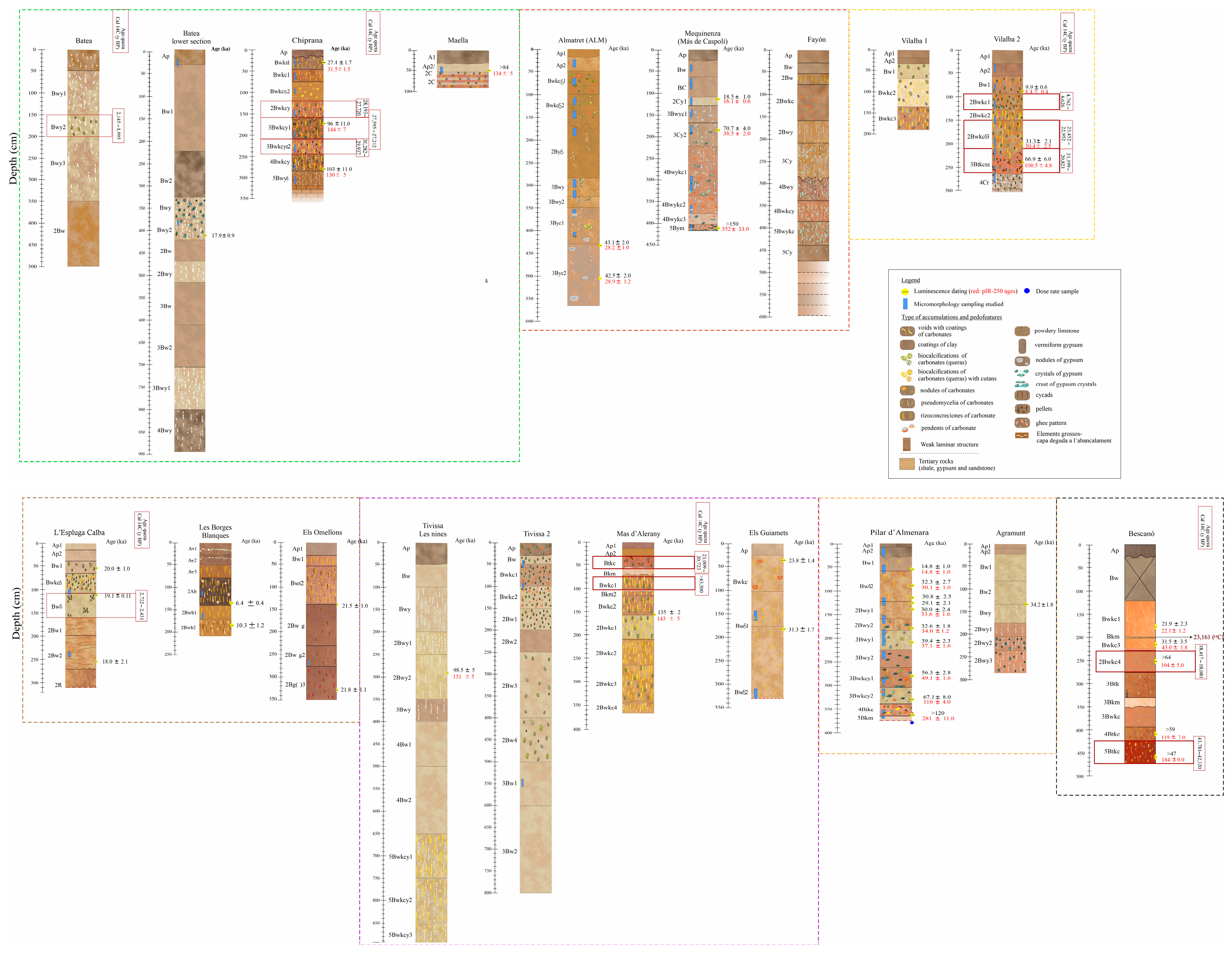
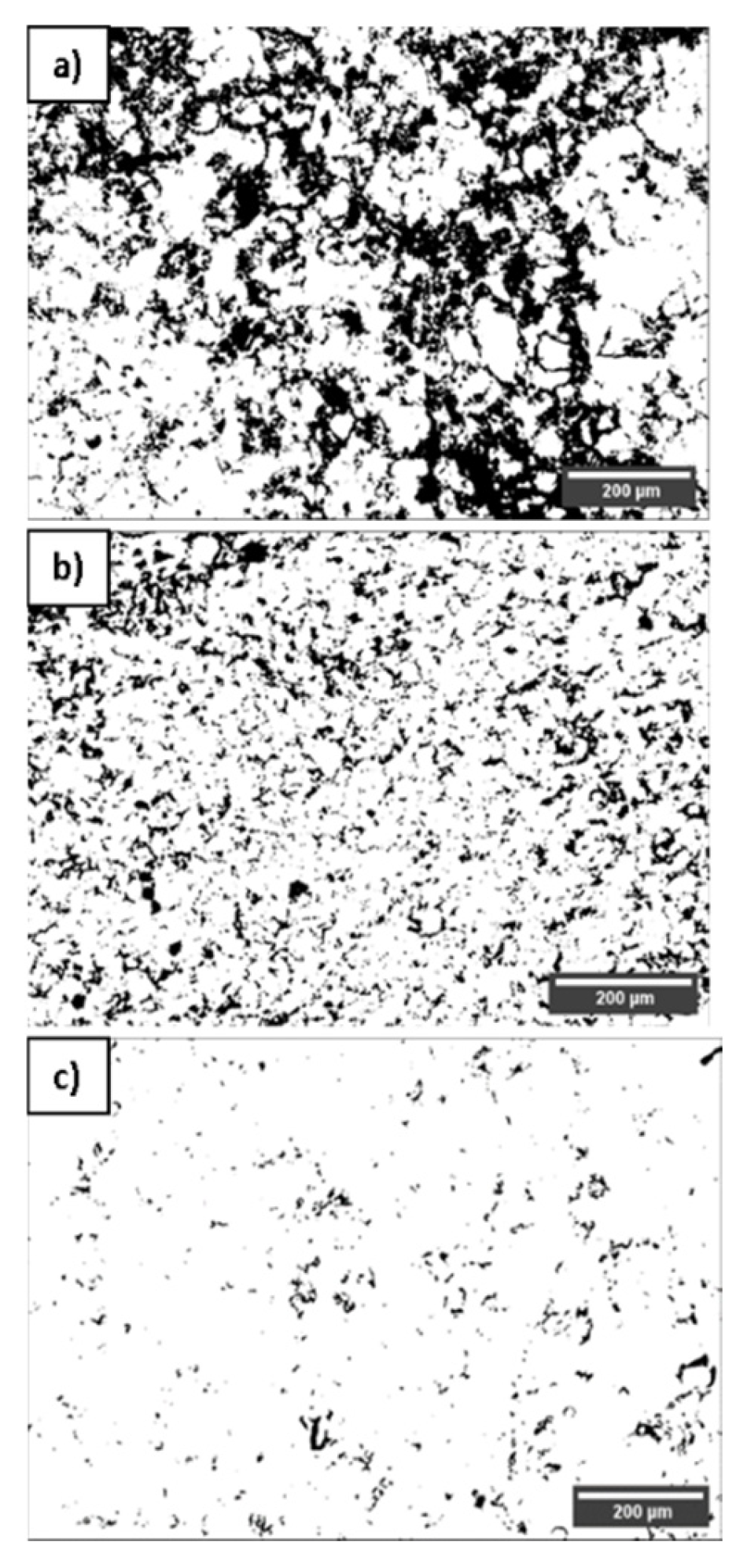


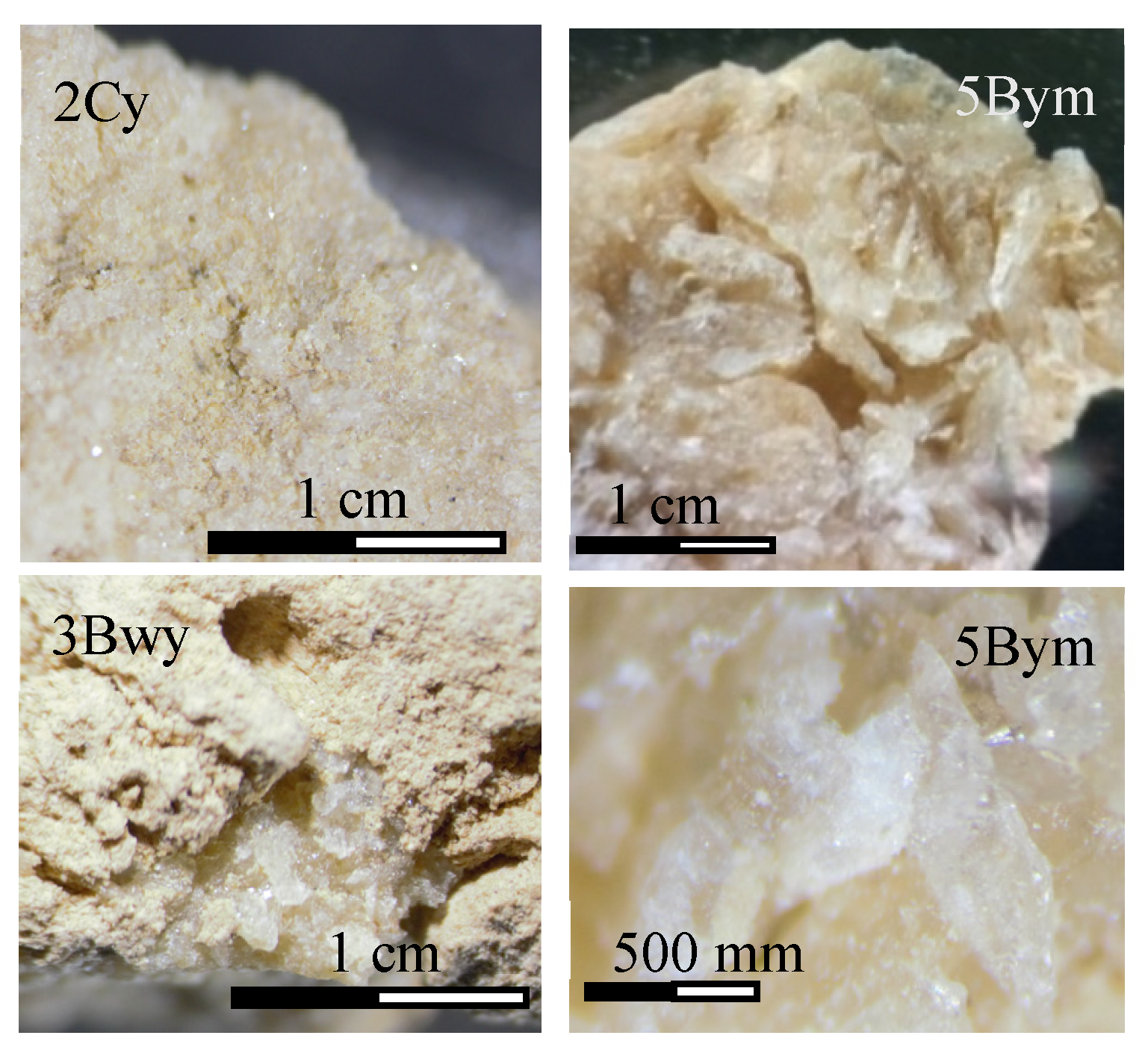
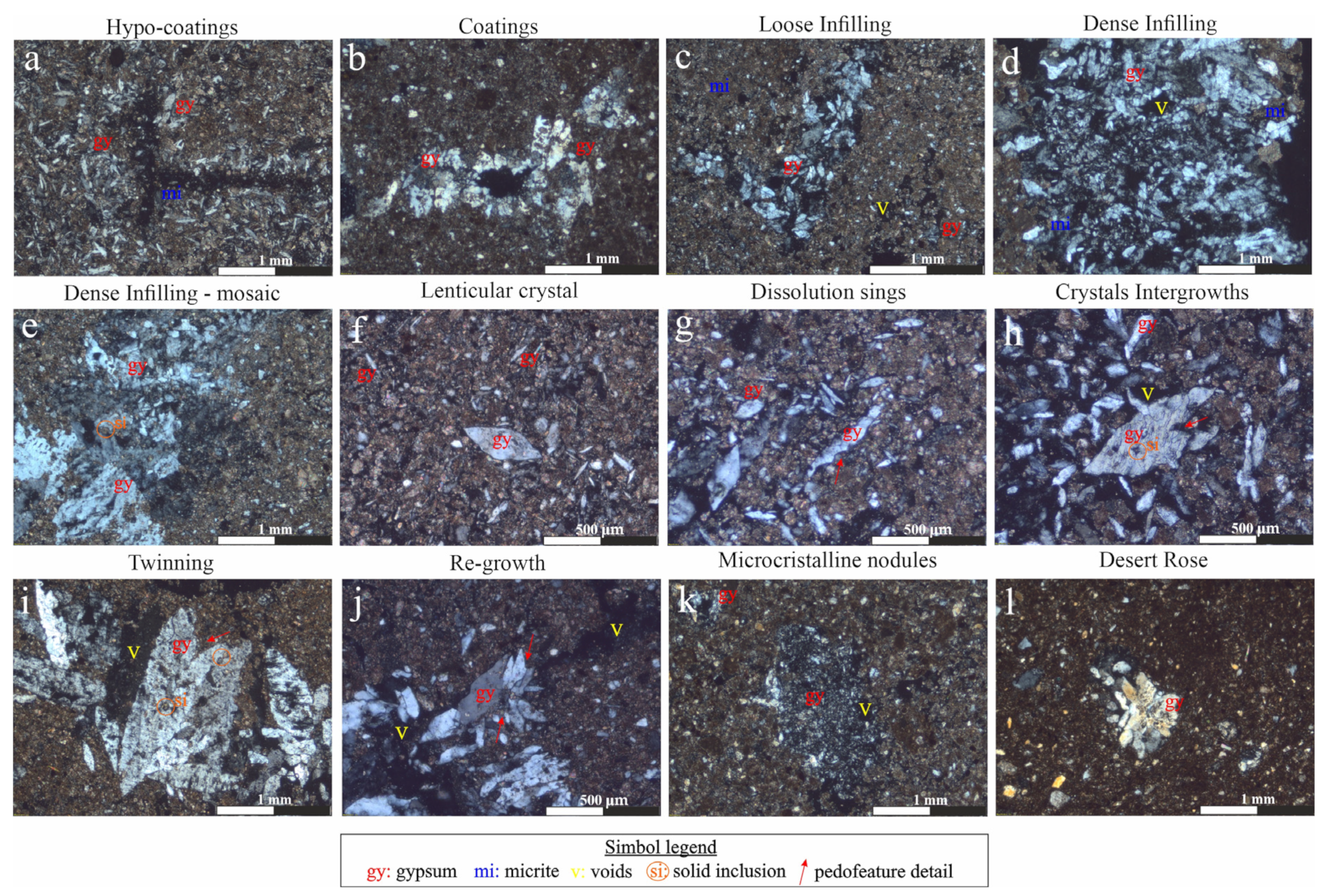
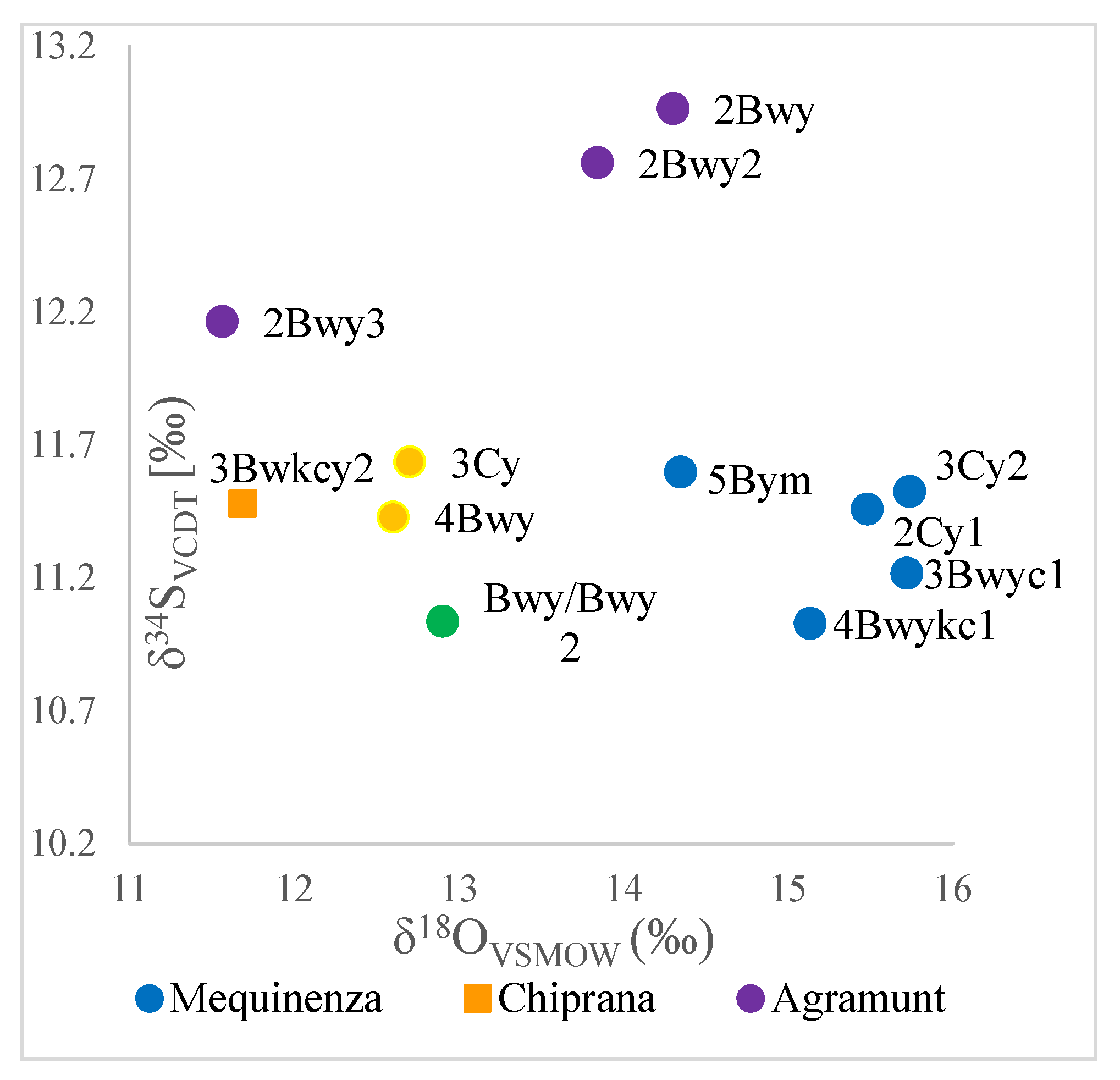
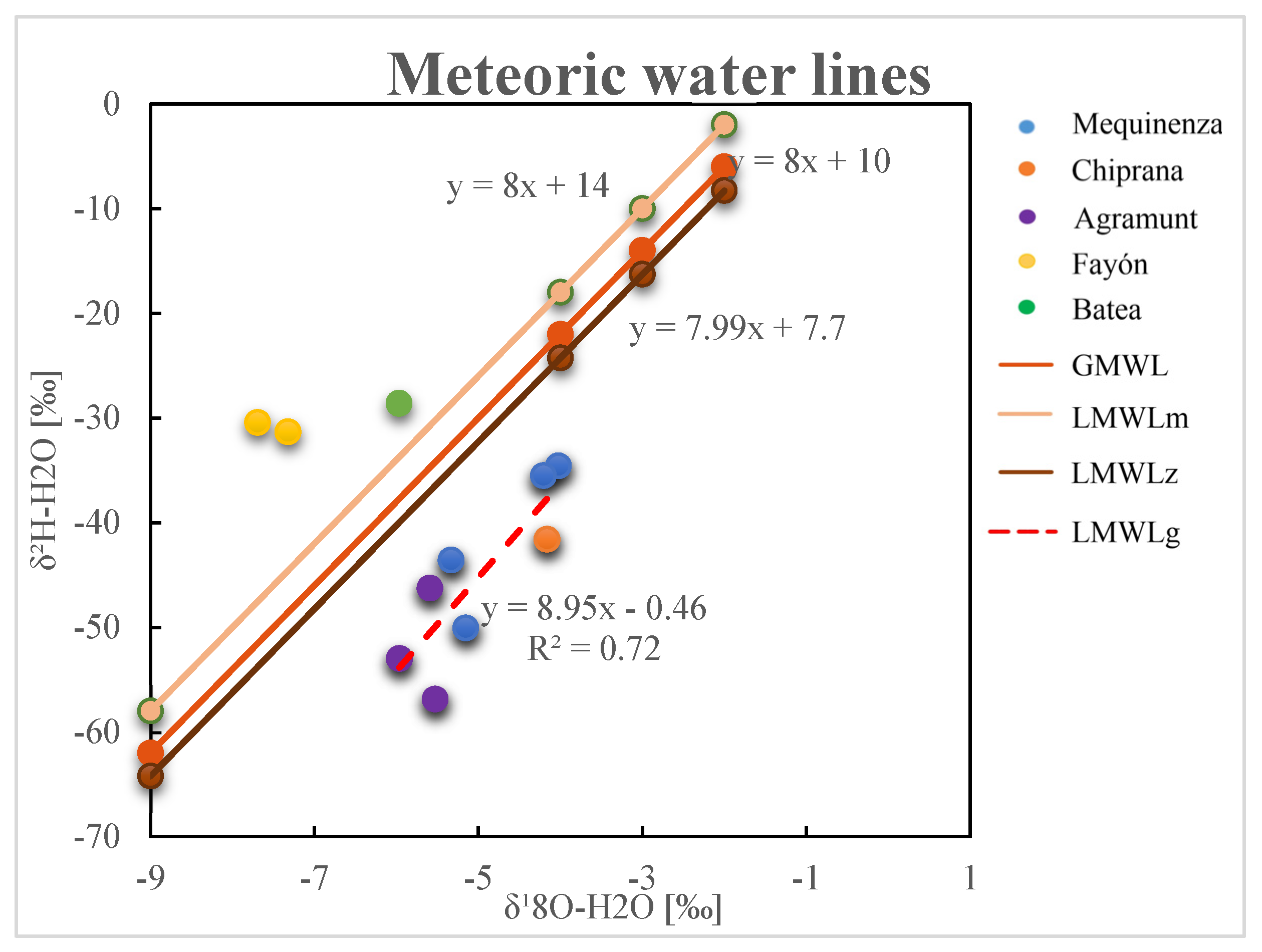


| OSL Sample | Depth (cm) | n | Radionuclide Concentration | Dose Rate (DR) (Gy ka−1) | Over Dispersion n (%) | De OSL (Gy) | Age OSL (ka) | ||
|---|---|---|---|---|---|---|---|---|---|
| 238U (mg/kg) | 232Th (mg/kg) | 40K (%) | |||||||
| BB1 | 135 | 32 | 2.8 ± 0.2 | 9.1 ± 0.5 | 1.46 ± 0.04 | 2.7 ± 0.2 | 24 | 17.1 ± 0.8 | 6.4 ± 0.4 |
| BB2 | 183 | 32 | 3.1 ± 0.2 | 10.95 ± 0.6 | 1.17 ± 0.03 | 2.6 ± 0.3 | 38 | 26.6 ± 3.0 | 10.3 ± 1.2 |
| EC1 | 55 | 24 | 2.3 ± 0.1 | 7.2 ± 0.5 | 1.08 ± 0.03 | 2.1 ± 0.1 | 14 | 42.4 ± 1.6 | 20.0 ± 1.0 |
| EC2 | 115 | 24 | 2.5 ± 0.1 | 7.7 ± 0.5 | 1.09 ± 0.03 | 2.2 ± 0.1 | 15 | 41.6 ± 1.6 | 19.1 ± 0.1 |
| EC3 | 255 | 24 | 2.8 ± 0.2 | 9.1 ± 0.5 | 1.07 ± 0.03 | 2.3 ± 0.3 | 28 | 41.3 ± 4.7 | 18.0 ± 2.1 |
| OMS1 | 140 | 24 | 2.6 ± 0.1 | 8.1 ± 0.5 | 1.24 ± 0.03 | 2.4 ± 0.1 | 15 | 50.5 ± 1.9 | 21.5 ± 1.0 |
| OMS2 | 330 | 24 | 2.4 ± 0.2 | 7.9 ± 0.5 | 1.30 ± 0.04 | 2.4 ± 0.1 | 19 | 51.3 ± 1.9 | 21.8 ± 1.1 |
Disclaimer/Publisher’s Note: The statements, opinions and data contained in all publications are solely those of the individual author(s) and contributor(s) and not of MDPI and/or the editor(s). MDPI and/or the editor(s) disclaim responsibility for any injury to people or property resulting from any ideas, methods, instructions or products referred to in the content. |
© 2025 by the authors. Licensee MDPI, Basel, Switzerland. This article is an open access article distributed under the terms and conditions of the Creative Commons Attribution (CC BY) license (https://creativecommons.org/licenses/by/4.0/).
Share and Cite
Álvarez, D.; Torres-Guerrero, C.A.; Boixadera, J.; Balasch, C.; Plata, J.M.; Rodríguez Ochoa, R.; Olarieta, J.R.; Poch, R.M. Palaeoenvironmental Synthesis of the Eastern Ebro Basin Loess–Palaeosol Sequences (LPSs). Quaternary 2025, 8, 25. https://doi.org/10.3390/quat8020025
Álvarez D, Torres-Guerrero CA, Boixadera J, Balasch C, Plata JM, Rodríguez Ochoa R, Olarieta JR, Poch RM. Palaeoenvironmental Synthesis of the Eastern Ebro Basin Loess–Palaeosol Sequences (LPSs). Quaternary. 2025; 8(2):25. https://doi.org/10.3390/quat8020025
Chicago/Turabian StyleÁlvarez, Daniela, Carlos Alberto Torres-Guerrero, Jaume Boixadera, Carles Balasch, José Manuel Plata, Rafael Rodríguez Ochoa, José Ramón Olarieta, and Rosa M. Poch. 2025. "Palaeoenvironmental Synthesis of the Eastern Ebro Basin Loess–Palaeosol Sequences (LPSs)" Quaternary 8, no. 2: 25. https://doi.org/10.3390/quat8020025
APA StyleÁlvarez, D., Torres-Guerrero, C. A., Boixadera, J., Balasch, C., Plata, J. M., Rodríguez Ochoa, R., Olarieta, J. R., & Poch, R. M. (2025). Palaeoenvironmental Synthesis of the Eastern Ebro Basin Loess–Palaeosol Sequences (LPSs). Quaternary, 8(2), 25. https://doi.org/10.3390/quat8020025







